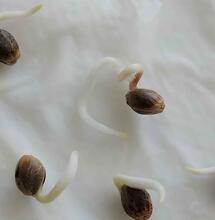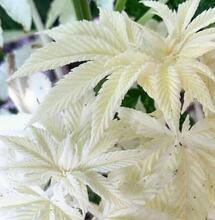Cloning for Success
_25.jpg)
Successful cloning for soil or mixed media is simple. A few easy guidelines will allow you to, over time, take one plant and make as many genetically identical copies as you want, for as long as you want. Several European cultivars of grapes are clones of plants originally grown over two-thousand years ago. Keeping a great strain is definitely a good reason for learning how to clone.
Successful cloning for soil or mixed media is simple. A few easy guidelines will allow you to, over time, take one plant and make as many genetically identical copies as you want, for as long as you want. Several European cultivars of grapes are clones of plants originally grown over two-thousand years ago. Keeping a great strain is definitely a good reason for learning how to clone.
Environment:
Several procedures and arrangements need to be accomplished before your first cutting is taken. A clone area with moderate- to low-level lighting is ideal for fresh cuttings. You want your plants focused on root formation, and bright lights will divert energy away from that endeavor. Most Cannabis strains need at least one month after sprouting from seed to be able to flower. Growers are able to control a plant's ability to flower by controlling the amount of darkness it receives.
This reaction to the light cycle or lack of light is called 'photoperiodic response'. 'Photoperiodism' controls a plant's circadian clock, a biochemical mechanism, which is literally a molecular clock coordinated with the day/ night cycle. We humans are also controlled by these circadian rhythms, but most are blissfully unaware. Cannabis is considered a short-day plant, as in nature, it flowers with the increase of darkness as autumn occurs. Between sixteen and twenty-four hours of light is necessary to prevent flowering in your clone area. Controlling temperature and humidity are very important when cloning Cannabis.
As with brewing beer or growing mushrooms, the parameters are very narrow, so purchasing a digital thermometer / hygrometer will take all the guesswork out of the equation. The closer your clone area is to the ideal 75° F (24° C), the more success you will have. The lower your temperatures drop, the slower your roots will form. Higher temperatures increase the chance of rotting your cutting before roots are formed. A plant clipping without roots is in an unquestionably delicate state. Without water, wilting begins almost immediately. A clone dome will ensure moisture stays in the air so your cutting does not dry out before roots develop. The cutting will absorb this moisture though a process of diffusion and osmosis. Marking or labeling is very important if you have more than one similar variety. It can be very easy to lose track of which plant is which. Get your containers labeled correctly so you do not end up losing or mixing up your strains. A marker and masking tape is an efficient and simple way to go.
The best media combination to clone with is a half vermiculite, half perlite blend. Together these two ingredients make the perfect jumble of moisture and oxygen for root development. A little misting will help keep the dust down when mixing these constituents, as they absolutely are a dust hazard. After being put into the cloning containers this blend needs to be saturated with water. To increase your level of success, adding a little 'Super Thrive' and/or a very diluted bloom mix to this water will help give your cuttings a boost in root production, due to the hormones and nutrients they provide. After watering the containers and making sure they are not sitting in puddles, create small holes in your media so your cuttings will not be damaged when placing them into the mix. The stems of most cuttings are tender. Forcing your clones into this medium would hurt them.
Mother Plants and Cutting Technique:
Healthy mothers ensure healthy clones. Some growers subscribe to starving mothers of nutrients before cloning, claiming that it helps clones take faster. (This makes as much sense as saying that starving a child makes him grow faster.) Your cuttings will use the nutrients stored within them for staying alive and creating new roots. Mother plants also need to be well-hydrated before cloning; it is optimal to water a few hours, or the day before, taking cuttings.
It will be around two weeks before the clones will need to be watered. Spray the mother plants with water before starting the procedure, just to make sure they are super-saturated. Now you are ready to determine where the clippings will be taken on the mother plant. A cutting around three-plus inches long is a good size. Use clean, sharp scissors to take the clipping. Place the cutting on a wood block, trim off the bottom leaves and cut the stem at a nice 45° angle with a fresh razor blade. Immediately dip the cutting into a wet or dry rooting hormone and place it into your medium. Make sure to gently pack the moist vermiculite and perlite, blending snugly around the stem. When you are finished with your last cutting, place the dome over them.
These new plants can be left in the clone area, undisturbed, for seven days. You ought to see a little humidity forming in the hood of the dome. This is a good sign that your clippings will have enough moisture in the air to sustain them while the roots are forming. If your plants wilt in the first few days, your conditions are too dry. If they rot the conditions are too wet, or to hot. After the first week, lift the dome every day or two allowing for a good air exchange, as roots need oxygen to survive.
Most cuttings will root within a three- to twelve day period. As Sophocles says, “success is dependent on effort.” These simple steps can give you 100% success at cloning. Once your clones are ready, transplant into soil, clay pellets, coconut husks, lava rock, or some other exotic medium. These plants are genetic copies of their mothers, ready to flower instantly with a reduced light cycle, meaning more potential harvests of your favorite medicine every year!



